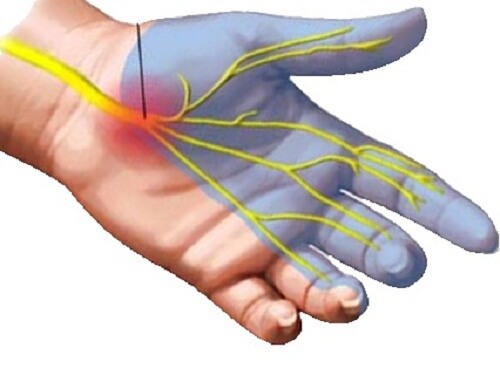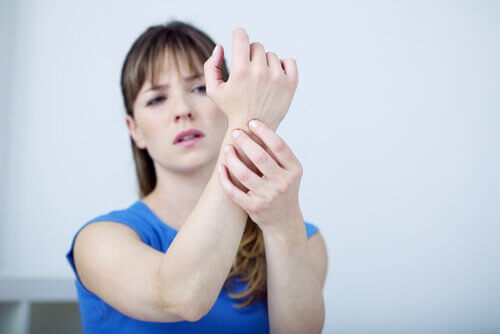Five Effective Exercises that Relieve Carpal Tunnel Pain

Carpal tunnel pain can have several origins. However, constantly moving your wrist can cause that bothersome inflammation, which usually takes place due to using the computer mouse too much.
According to trusted sources like the American Family Physician medical journal, treatment for carpal tunnel can include splints, corticosteroids, physical therapy, therapeutic ultrasound, and yoga. However, the choice between one option or another will depend on the medical diagnosis.
Therefore, although you can help yourself with some exercises that promote your recovery, it’s important to go to the doctor and follow their recommendations. You can’t ignore that, depending on your case, you may need other therapeutic options. Below, discover five effective exercises.
What causes carpal tunnel pain?

According to Mayo Clinic, the origin of carpal tunnel pain is usually, in most cases, the result of several factors:
- Obesity
- Bodily fluid changes
- Tension or stiffness of the joints and tendons.
- A tendency to experience swelling due to genetics, injuries, etc.
- Repetitive and continuous hand or wrist movements or positions. For example, when working with a specific device, when playing a musical instrument, when using a computer mouse, or when using a cell phone.
Exercises for carpal tunnel syndrome
According to experts from the American Academy of Orthopedic Surgeons (AAOS), if you suffer from carpal tunnel pain, your doctor may suggest an exercise program. This is because they help reduce pressure on the median nerve in the wrist.
The Mayo Clinic points out that, by themselves, these exercises will do little or nothing against pain. For this reason, experts often advise complementing them with other therapeutic measures such as behavioral changes, medications, or wrist splints.
1. Stretching before, during, and after
If you know you have carpal tunnel pain due to being in the same position or doing the same hand movements, then you should stretch on a daily basis. You should do these exercises throughout the day. If possible, you should do them before, during, and after using your wrists.
The most important stretch consists in putting your arm in front of you – horizontally – and raising your hand perpendicular to your body. The gesture is just like telling someone to stop. You’ll feel slight discomfort and tension in the hand and wrist, which means you’re doing it correctly.
2. Movements and warming up
Secondly, after stretching the tendons, you should do a brief warm up to get rid of the stiffness. You can do this by performing gentle movements that activate all possible positions of the hands and wrists.
Do circular motions with your wrist, in both directions, for approximately 1 minute. Try your best at doing full circles motions because the inflammation will eventually limit your range of motion.
Discover: 6 Hand Exercises to Prevent Annoying Syndromes
3. Heated massage

When you experience acute inflammation by a bruise, for example, you can apply an ice pack to relieve it. However, when the inflammation is chronic, it could be useful to apply heat to it. In this case, you can relieve carpal tunnel pain.
A good way to do this is to heat the affected area is by getting a massage or performing a massage during in the morning and evenings. It’s recommended to use olive oil or sesame seeds. Likewise, if you want to, you can add a few drops of ginger or cinnamon essential oil.
4. Contrasts baths
Hot and cold contrast baths are another way to activate blood circulation. This technique, which has been done since ancient times in different ways, is used to reduce swelling and pain.
How to do contrast baths
- Use two containers, one of them with cold water and the other with hot water.
- Dip your hands and wrists, even up to the elbow if you wish, for 30 seconds in the hot water and 15 seconds in cold water.
- Each session should last for at least three minutes and be repeated throughout the day.
- Reduce the repetitions as the pain goes away.
5. Stress balls
One of the most common exercises in physiotherapists is a doing a rehabilitation routine with stress balls. The act of the hands squeezing a simple rubber or foam ball helps exercise the muscles and tendons that pass through the carpal tunnel.
As you recover your strength and mobility, you can use another harder ball. This exercise is also good for the finger muscles and fights the stiffness that comes along with the carpal tunnel pain.
Exercises are an adjunctive treatment
You can use simple exercises to help relieve carpal tunnel pain. However, you must bear in mind that they can’t rehabilitate it on their own. Therefore, you must consult your doctor to receive a more complete treatment.
All cited sources were thoroughly reviewed by our team to ensure their quality, reliability, currency, and validity. The bibliography of this article was considered reliable and of academic or scientific accuracy.
- Mooar, P. A., Doherty, W. J., Murray, J. N., Pezold, R., & Sevarino, K. S. (2018). Management of Carpal Tunnel Syndrome. Journal of the American Academy of Orthopaedic Surgeons. https://doi.org/10.5435/JAAOS-D-17-00451
- Duckworth, A. D., Jenkins, P. J., Roddam, P., Watts, A. C., Ring, D., & McEachan, J. E. (2013). Pain and carpal tunnel syndrome. Journal of Hand Surgery. https://doi.org/10.1016/j.jhsa.2013.05.027
- Atroshi, I., Gummesson, C., Johnsson, R., Ornstein, E., Ranstam, J., & Rosen, I. (1999). Prevalence of Carpal Tunnel Syndrome. JAMA. https://doi.org/10.1001/jama.282.2.153
- Lawrence, R. C., Felson, D. T., Helmick, C. G., Arnold, L. M., Choi, H., Deyo, R. A., … Wolfe, F. (2008). Estimates of the prevalence of arthritis and other rheumatic conditions in the United States. Part II. Arthritis and Rheumatism. https://doi.org/10.1002/art.23176
- Padua, L., Coraci, D., Erra, C., Pazzaglia, C., Paolasso, I., Loreti, C., … Hobson-Webb, L. D. (2016). Carpal tunnel syndrome: clinical features, diagnosis, and management. The Lancet Neurology. https://doi.org/10.1016/S1474-4422(16)30231-9
This text is provided for informational purposes only and does not replace consultation with a professional. If in doubt, consult your specialist.








